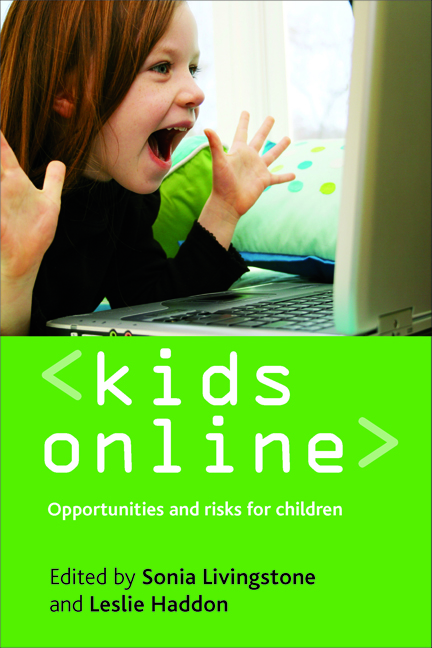Book contents
- Frontmatter
- Contents
- Notes on contributors
- Acknowledgements
- one Introduction
- Section I Researching European children online
- Section II Going online: new opportunities?
- Section III Going online: new risks?
- Section IV Policy implications
- Appendix A List of country codes
- Appendix B Children and parents online, by country
- Appendix C The EU Kids Online network
ten - Risky contacts
Published online by Cambridge University Press: 15 July 2022
- Frontmatter
- Contents
- Notes on contributors
- Acknowledgements
- one Introduction
- Section I Researching European children online
- Section II Going online: new opportunities?
- Section III Going online: new risks?
- Section IV Policy implications
- Appendix A List of country codes
- Appendix B Children and parents online, by country
- Appendix C The EU Kids Online network
Summary
Introduction
One of the anxieties regarding children's internet use relates to the potential for risky contacts (see, for example, EC, 2008). This chapter critically reviews the latest findings and theories on children's risky contacts with adults and children – grooming, harassment and meetings – in order to identify who is really at risk from what. Two primary types of risks will be discussed: children and young people as victims of aggressive communication and as victims of sexually oriented communication. This discussion will expand our current understanding of both media and social psychological dimensions of the misuse and abuse of the internet, which in turn can enable industry, policy makers and future generations to approach and develop an online environment that poses fewer dangers.
The specific characteristics of online communication that appear to lower thresholds to find, contact and interact with others have led to perceptions that dangerous encounters are likely. Media panics similarly emphasise the dangers represented by adults with intentions of deceiving children and young people online (Weathers, 2008). Whereas this is indeed a risk, with potentially grave and tragic outcomes, research shows that children and young people are quick to emphasise that they are aware of ill-intended adults online, and that they take action to prevent such contact (Dunkels, 2008). However, research concerning what counter-strategies are actually helpful is conspicuous by its absence. Children may be regarded as native users of contemporary technology, but there is little research on the effectiveness of their often self-taught strategies to avoid online victimisation. Young people who are at risk of meeting adults typically already face serious problems offline (Shannon, 2007), and often they are not being deceived (Ybarra et al, 2007). The most likely scenario is that a sexual predator takes advantage of the fact that a child discloses vulnerability online. The predator offers to be an understanding and supporting adult and starts building a manipulative relationship with the child. When this process, called grooming, is completed, the potential victim often readily travels to meet the predator, even if aware of the adult's sexual intentions.
- Type
- Chapter
- Information
- Kids OnlineOpportunities and Risks for Children, pp. 123 - 134Publisher: Bristol University PressPrint publication year: 2009

